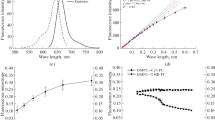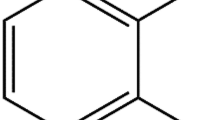Abstract
Förster resonance energy transfer (FRET) between anthrylvinyl-labeled phosphatidylcholine (AV-PC) as a donor and newly synthesized benzanthrones (referred to here as A8, A6, AM12, AM15 and AM18) as acceptors has been examined to gain insight into molecular level details of the interactions between benzanthrone dyes and model lipid membranes composed of zwitterionic lipid phosphatidylcholine and its mixtures with anionic lipids cardiolipin (CL) and phosphatidylglycerol (PG). FRET data were quantitatively analyzed in terms of the model of energy transfer in two-dimensional systems taking into account the distance dependence of orientation factor. Evidence for A8 location in phospholipid headgroup region has been obtained. Inclusion of CL and PG into PC bilayer has been found to induce substantial relocation of A6, AM12, AM15 and AM18 from hydrophobic membrane core to lipid-water interface.




Similar content being viewed by others
References
Dobretsov G, Dmitriev V, Pirogova L, Petrov V, Vladimirov Y (1978) 4-Dimethylaminochalcone and 3-methoxybenzanthrone as fluorescent probes to study biomembranes. III Relationship between state of hydration shell of membrane and state of phospholipids. Stud Biophys 71:189–196
Yang X, Liu W-H, Jin W-J, Shen G-L, Yu R-Q (1999) DNA binding studies of a solvatochromic fluorescence probe 3-methoxybenzanthrone. Spectrochim Acta A 55:2719–2727
Kirilova E, Kalnina I (2010) 3-isopropyloxy-6-morpholino-2-phenylphenalen-1-one as lipophilic fluorescent probe for lymphocyte investigations. Appl Biochem Biotechnol 160:1744–1751
Kalnina I, Klimkane L, Kirilova E, Toma M, Kizane G, Meirovics I (2007) Fluorescent probe ABM for screening gastrointestinal patient’s immune state. J Fluoresc 17:619–625
Gorbenko G, Trusova V, Kirilova E, Kirilov G, Kalnina I, Vasilev A, Kaloyanova S, Deligeorgiev T (2010) New fluorescent probes for detection and characterization of amyloid fibrils. Chem Phys Lett 495:275–279
Vus K, Trusova V, Gorbenko G, Kirilova E, Kirilov G, Kalnina I, Kinnunen P (2012) Novel aminobenzanthrone dyes for amyloid fibril detection. Chem Phys Lett 532:110–115
Kirilova E, Kalnina I, Kirilov G, Meirovics I (2008) Spectroscopic study of benzanthrone 3-N-derivatives as new hydrophobic fluorescent probes for biomolecules. J Fluoresc 18:645–648
Refat M, Aqeel S, Grabtchev I (2004) Spectroscopic and physicochemical studies of charge-transfer complexes of some benzanthrone derivatives “Luminophore Dyes” with iodine as σ-acceptor. Can J Anal Sci Spectrosc 49:258–265
Grabchev I, Bojinov V, Moneva I (1998) Functional properties of azomethine substituted benzanthrone dyes for use in nematic liquid crystals. J Mol Struct 471:19–25
Lakowicz J (1999) Principles of fluorescent spectroscopy, 2nd edn. Plenum Press, New York
Trusova V, Kirilova E, Kalina I, Kirilov G, Zhytniakivska O, Fedorov P, Gorbenko G (2012) Novel benzanthrone aminoderivatives for membrane studies. J Fluoresc 22:953–959
Zhytniakivska O, Trusova V, Gorbenko G, Kirilova E, Kalnina I, Kirilov G, Kinnunen P (2014) Newly synthesized benzanthrone derivatives as prospective fluorescent membrane probes. J Lumin 146:307–313
Fung B, Stryer L (1978) Surface density determination in membranes by fluorescence energy transfer. Biochemistry 17:5241–5248
Bergelson L, Molotkovsky J, Manevich Y (1985) Lipid-specific probes in studies of biological membranes. Chem Phys Lipids 37:165–195
Molotkovsky J, Dmitriev P, Nikulina L, Bergelson L (1979) Synthesis of new fluorescent labeled phosphatidylcholines. Bioorg Khim 5:588–594
Gonta S, Utinans M, Kirilov G, Belyakov S, Ivanova I, Fleisher M, Savenkov V, Kirilova E (2013) Fluorescent substituted amidines of benzanthrone: synthesis, spectroscopy and quantum chemical calculations. Spectrochim Acta A 101:325–334
Bulychev A, Verchoturov V, Gulaev B (1988) Current methods of biophysical studies. Vyschaya shkola, Moscow
Santos N, Prieto M, Castanho M (2003) Quantifying molecular partition into model systems of biomembranes: an emphasis on optical spectroscopic methods. Biochim Biophys Acta 1612:123–135
Ivkov V, Berestovsky G (1981) Dynamic structure of lipid bilayer. Nauka, Moscow
Gorbenko G, Kinnunen P (2013) FRET analysis of protein-lipid interactions. Springer Ser Fluoresc Fluorescent Methods Study Biol Membr 13:115–140
Ardail D, Privat J, Egretcharlier M, Levrat C, Lerme F, Louitson P (1990) Mitochondrial contact sites—lipid composition and dynamics. J Biol Chem 265:18797–18802
Flewelling R, Hubbel W (1986) The membrane dipole potential in a total membrane potential model. Application to hydrophobic ion interaction with membranes. Biophys J 49:541–552
Ceve G (1990) Membrane electrostatics. Biochim Biophys Acta 1031:311–382
Franklin J, Cafiso D (1995) Internal electrostatic potentials in bilayers: measuring and conrolling dipole potentials in lipid vesicles. Biophys J 65:289–299
Zhao G-J, Han K-l (2012) Hydrogen bonding in the electronic excited state. Acc Chem Res 45:404–413
Zhao G-J, Liu J-Y, Zhou L-C, Han K-L (2007) Site-selective photoinduced electron transfer from alcoholic solvents to the chromophore facilitated by hydrogen bonding: a new quenching mechanism. J Phys Chem B 111:8940–8945
Zhang M-X, Zhao G-J (2012) Modification of n-type organic semiconductor performance of perylene diimides by substitution in different positon: two-dimensional π-stacking and hydrogen bonding. ChemSusChem 5:879–887
Johansson L, Molotkovsky J, Bergelson L (1990) Fluorescence properties of anthrylvinyl lipid probes. Chem Phys Lipids 53:185–189
Molotkovsky J, Manevich E, Gerasimova E, Molotkovskaya I, Polessky V, Bergelson L (1982) Differential study of phosphatidylcholine and sphingomyelin in human high-density lipoproteins with lipid-specific fluorescent probes. Eur J Biochem 122:573–579
Boldyrev I, Zhai X, Momsen M, Brockman H, Brown R, Molotkovsky J (2007) New BODIPY lipid probes for fluorescence studies of membranes. J Lipid Res 48:1518–1532
Wiener M, White S (1992) Structure of a fluid dioleoylphosphatidylcholine bilayer determined by joint refinement of X-ray and neutron diffraction data. Biophys J 61:437–447
Epand R, Kraaychenhof R (1999) Fluorescent probes to monitor membrane interfacial polarity. Chem Phys Lipids 101:57–64
Bagatolli L (2006) To see or not to see: lateral organization of biological membranes and fluorescence microscopy. Biochim Biophys Acta 1758:1541–1556
Chong P (1988) Effects of hydrostatic pressure on the location of Prodan in lipid bilayers and cellular membranes. Biochemistry 27:399–404
Bondar O, Rowe E (1999) Preferential interactions of fluorescent probe Prodan with cholesterol. Biophys J 76:956–962
Mukherjee S, Raghuraman H, Chattopadhyay A (2007) Membrane localization and dynamics of Nile Red: effect of cholesterol. Biochim Biophys Acta 1768:58–66
Alakoskela JMI, Kinnunen PKJ (2001) Probing phospholipid main phase transition by fluorescence spectroscopy and a surface redox reaction. J Phys Chem B 105:11294–11301
Klymchenko A, Duportail G, Demchenko A, Mely Y (2004) Bimodal distribution and fluorescence response of environment-sensitive probes in lipid bilayers. Biophys J 86:2929–2941
Etienne F, Roche Y, Peretti P, Bernard S (2008) Cardiolipin packing ability studied by grazing incidence X-ray diffraction. Chem Phys Lipids 152:13–23
Nichols-Smith S, The S-Y, Kuhl T (2004) Thermodynamic and mechanical properties of model mitochondrial membranes. Biochim Biophys Acta 1663:82–88
Domenech O, Sanz F, Montero M, Hernandez-Borell J (2006) Thermodynamic and structural study of the main phospholipids components comprising the mitochondrial inner membrane. Biochim Biophys Acta 1758:213–221
Chen Q, Li Q (2001) Effect of cardiolipin on proton permeability of phospholipid liposomes: the role of hydration at the lipid-water interface. Arch Biochem Biophys 389:201–206
Shibata A, Ikawa K, Shimooka T, Terada H (1994) Significant stabilization of the phosphatidylcholine bilayer structure by incorporation of small amounts of cardiolipin. Biochim Biophys Acta 1192:71–78
Sparrman T, Westlund P (2003) An NMR line shape and relaxation analysis of heavy water powder spectra of the L-alpha, L-beta and P-beta phases in the DPPC/water system. Phys Chem Chem Phys 5:2114–2121
MacDonald P, Seelig J (1987) Calcium binding to cardiolipin-phosphatidylcholine bilayers as studied by deuterium nuclear magnetic resonance. Biochemistry 26:6292–6298
Pinjeiro T, Andeezei A, Duralski A, Watts A (1994) Phospholipid headgroup-headgroup electrostatic interactions in mixed bilayers of cardiolipin with phosphatidylcholines studied by 2H NMR. Biochemistry 33:4896–4902
MacDonald P, Seelig J (1987) Calcium binding to mixed phosphatidylglycerol-phosphatidylcholine bilayers as studied by deuterium nuclear magnetic resonance. Biochemistry 26:1231–1240
Scherer P, Seelig J (1987) Structure and dynamics of the phosphatidylcholine and phosphatidylcholine headgroup in L-M fibroblasts as studied by deuterium nuclear magnetic resonance. EMBO J 6:2915–2922
Murzyn K, Rog T, Pasenkiewier-Gierula M (2005) Phosphatidylethanolamine-phosphatidylglycerol bilayer as a model of the inner bacterial membrane. Biophys J 88:1091–1103
Tari A, Huang L (1989) Structure and function relationship of phosphatidylglycerol in the stabilization of the phosphatidylethanolamine bilayer. Biochemistry 28:7708–7712
Acknowledgments
This work was supported by the grant from Fundamental Research State Fund (project number F.54.4/015) and CIMO Fellowship (OZ).
Author information
Authors and Affiliations
Corresponding author
Rights and permissions
About this article
Cite this article
Zhytniakivska, O., Trusova, V., Gorbenko, G. et al. Location of Novel Benzanthrone Dyes in Model Membranes as Revealed by Resonance Energy Transfer. J Fluoresc 24, 899–907 (2014). https://doi.org/10.1007/s10895-014-1370-7
Received:
Accepted:
Published:
Issue Date:
DOI: https://doi.org/10.1007/s10895-014-1370-7




